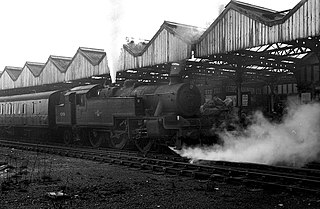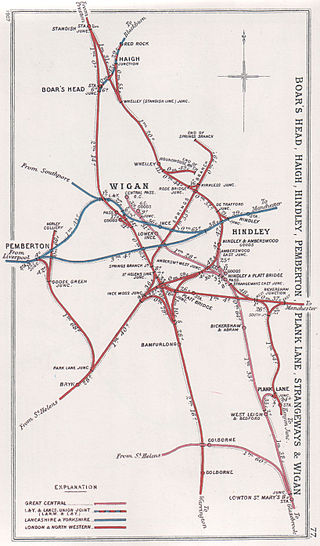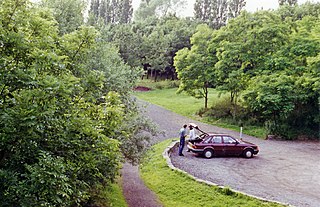The Liverpool, St Helens and South Lancashire Railway, was formed in 1889, but no services ran until 1895 and then only freight. Passenger services did not start until 1900. It incorporated the St Helens and Wigan Junction Railway. It was taken over by the Great Central Railway in 1906.

Wigan Central railway station was a railway station near the centre of Wigan, Lancashire, England.

Hindley South railway station served the communities of Hindley and Platt Bridge, south-east of Wigan, England.
Ashton-in-Makerfield railway station was a railway station serving the town of Ashton-in-Makerfield, although it was located in the neighbouring village of Haydock, formerly in Lancashire, England.

The railway system in Wigan started development in the 19th century during the Industrial Revolution. The first railway built in the town was the Wigan Branch Railway which was opened on 3 September 1832 to serve the many collieries in the area; this was a branch line of the Liverpool and Manchester Railway, the first inter-city railway. By the turn of the 20th century, Wigan had numerous railway stations widely available across the borough, used by both freight and passengers. Many of the lines were originally built for freight which were later converted, as the owners saw the profitability of allowing passengers, to carry passenger trains.

Culcheth railway station served the village of Culcheth, Lancashire, England. It was west of the bridge where Wigshaw Lane crossed the railway.
Newchurch Halt was a railway station on the former Wigan Junction Railways line between Glazebrook and Wigan Central.
Pennington railway station served Pennington, Leigh, Greater Manchester, England on the Bolton and Leigh Railway. It was situated within the historic county of Lancashire.

St Helens Central (GCR) railway station served the town of St Helens, England with passenger traffic between 1900 and 1952 and goods traffic until 1965. It was the terminus of a branch line from Lowton St Mary's.
Widnes Central railway station served the town of Widnes, England from 1879 to 1964.
The Widnes loop was a 5 miles 2 chains (8.1 km) railway line which served the town of Widnes, England from 1879 to 2000.
Haydock railway station served the village of Haydock, formerly in Lancashire, now in Merseyside, England.
Haydock Park railway station was a railway station adjacent to Haydock Park Racecourse, formerly in Lancashire and now in Merseyside, England. The station's sole purpose was to handle race day traffic. It did not feature in public timetables and normal service trains passed through the station without stopping.

Golborne North railway station served the town of Golborne, in the Metropolitan Borough of Wigan, Greater Manchester, England.
Lowton St Mary's railway station served the scattered community of Lowton, then in Lancashire, now in Greater Manchester, England. It was situated immediately south of the A572 bridge over the tracks.

Wigan Central railway station was a railway station near the centre of Wigan, Greater Manchester, England.

Lower Ince railway station was a railway station in southern Wigan, Lancashire, England.

Bickershaw and Abram railway station served the communities of Bickershaw and Abram southeast of Wigan, England.

The West Leigh and Bedford railway station served the hamlet of Crankwood, the village of Abram, and the Plank Lane area of Leigh, England. Like many railways, the line passed between rather than through communities, with branches off to serve the key driver - goods, and in this area - coal.

Park Lane Halt railway station was an unadvertised halt which served the communities of Bickershaw and Abram southeast of Wigan, England.








